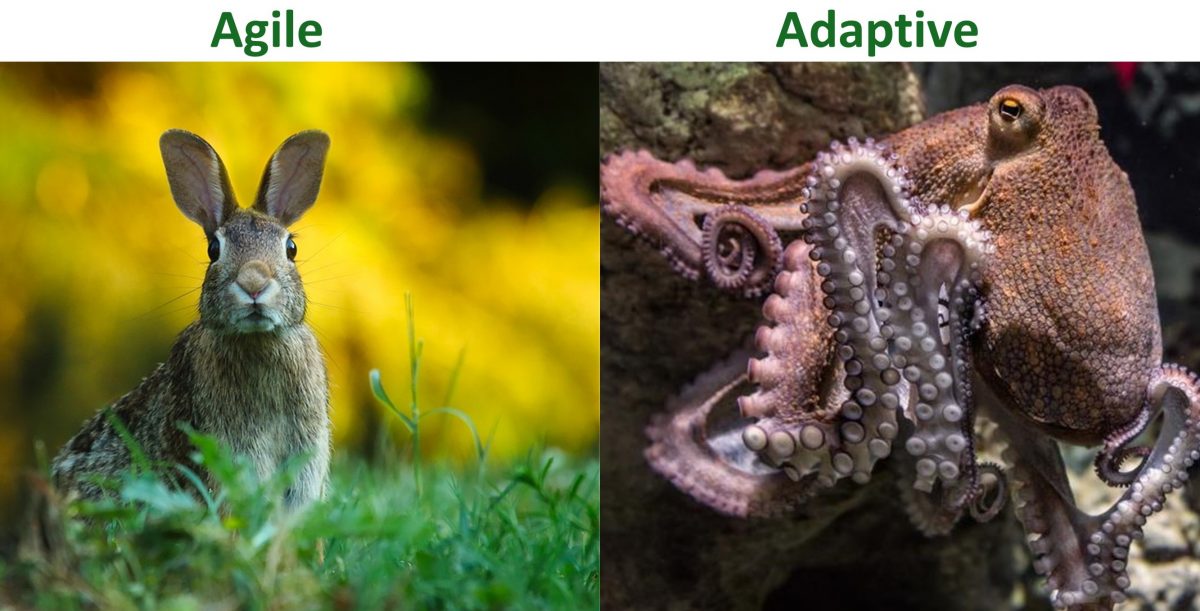Sustainability, the “ability to exist constantly” (wikipedia) is, for sure, a strength of enterprises of the old economy. Large enterprises have been around for many decades, a proof that they are running a sustainable business.
Nowadays, driven by disruptive forces, agility seams to have overtaken sustainability on the priority ranking of executive management. Boards of directors are aware that to survive in the era of startups their companies must transform in the direction of business agility i.e. to get in a state to “rapidly respond to change by adapting an initial stable configuration” (wikipedia). They invest huge amounts of money in Agile coaches believing that this is the way to improve business agility, but many times those coaches aren’t qualified. Organizations are looking for easy solutions to becoming agile and there aren’t any.
Having a cursory high-level glance at the two poles sustainability and agility it appears as if…
- agility interferes with the calmer flow of existing sustainable business models. Boating on rough waters into the unknown sea is a risk to sustainable survival. Is agility the enemy of sustainability?
- sustainability interferes with agility – implementing changes in the enterprise design sustainably means to think holistically and harder and thus to invest more time. Is sustainability the enemy of business agility?
No to both questions!
Agility and sustainability complement each other. They interrelate like the famous Chinese yin yang symbol that describes “how seemingly opposite or contrary forces may actually be complementary, interconnected, and interdependent in the natural world, and how they may give rise to each other as they interrelate to one another”.
But what does this mean?
1. Without a sustainable continuous strategy, you cannot be agile in the medium term.
The architecture of your enterprise supports an agile business only if it has been designed for change. The building of flexible business&IT solutions that fit together to form a sound business architecture needs commonly used elements and ‘conceptual integrity’. This means that the concepts and structures of the business (capabilities, value streams, products & services, business objects, organizational structures) and IT must play together to form an agile enterprise design that maximizes simplicity, consistency, and thus business agility.
You need to go slower in the short term to become/stay fast in the long term.
2. Without business agility, you cannot sustain…
…because you cannot adapt to changing environments – the startups will take over. The strategies of yesteryear don’t provide sustainability any more.
The secret path to true business agility seems to be to solve this sustainability/agility paradox. To find the right speed for building strategic solutions. To be fast enough to survive in constantly changing times but to take enough time to build sustainable. To balance speed/agility with sustainability.
Solution for this paradox? You must become a sustainably agile enterprise
What you should do to become a sustainably agile enterprise
- Create a lean, business-oriented architectural model of the existing structure of your enterprise collaboratively (involving business & IT people)
- Set up lean governance structures to enable sustainable strategic decisions based on the solid information of this architecture model
- Realizes small innovative minimum viable products (MVP) to evaluate new business opportunities using new technologies
- Once MVPs have proven to create business value: take your time to integrate them properly with your existing business&IT structures

Previous Posts:
AT#20: Why Digital Transformation fails without Architecture
AT#15: How to make decisions in uncertain Times
AT#10: Technical Debt – the ignored Killer of “Agile” Enterprises










